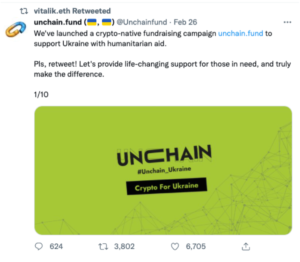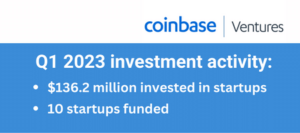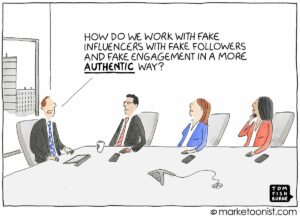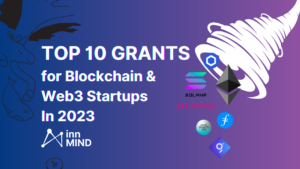This article aims to help web3 startup founders like you to get better prepared for fundraising from web3 investors. Understand how to nail your pitch and increase your chances of getting funded even in a bear market.
📩 And don’t forget to subscribe to our weekly newsletter: no spam, just practical tips and tools for reaching out to active crypto VCs, accessing invaluable web3 founders resources, and opening doors to potential investors and fundraising opportunities in the Web3 world.
Decoding Investor Psychology in the Web3 Space

Understanding investor psychology is crucial when you're seeking funding. This principle applies to both traditional (Web2) and emergent (Web3) venture capital sectors, with some notable differences.
Unlike traditional markets, Web3 investors often combine a unique blend of technological savvy, a penchant for innovation, and a willingness to embrace high risk. Simultaneously, Web3 and crypto investors typically look for shorter timelines for investment returns, reflective of the dynamic and liquid nature of token investments.
As a founder, you must realize that some crypto VCs invest in visions of the future shaped by blockchain technology and decentralized principles. Others seek clear, timed exit opportunities and liquid assets for their portfolios. Thus, communicating a clear, visionary roadmap for your project is as crucial as showcasing its current achievements, along with answering investors' questions about how they can earn and exit in the future.
Analyzing What Web3 Investors Look For

When pitching to Web3 investors, it's essential to understand their nuanced investment criteria. These investors evaluate startups based on various factors, unique to the Web3 space as well as traditional metrics.
Verticals: They assess the startup's niche within specific verticals like DeFi, Metaverse, SocialFi, GameFi, Infrastructure and so on. Each vertical comes with its own set of opportunities and challenges, and demonstrating a deep understanding of your chosen niche can set your pitch apart.
For example: while in 2021 the NFT market was booming and the majority of crypto VC investors shared a huge interest in investing in NFT startups, in “crypto winter” 2023 we see the opposite picture: the NFT sector is severely down, many investors fixed losses in their NFT portfolio deals, that made it incredibly difficult to secure VC funding nowadays for NFT startups.
Stage and Traction: The development stage of your startup and the traction it has gained in the market are critical. Early-stage startups might be evaluated more on their potential and team capabilities, while later-stage startups are expected to show significant market traction, product-market-fit and user adoption.
Team: The strength and expertise of your team are scrutinized, with a focus on your ability to execute the vision and navigate the challenges of the Web3 ecosystem.
Scalability and Blockchain Ecosystem: Investors look for startups with scalable solutions and consider the growth potential within the chosen blockchain ecosystem. How well your startup integrates with and leverages the strengths of its blockchain platform can be a deciding factor.
A clear shift in investors' interest is evident between different blockchain ecosystems. For example, during the 2021 bull run, many VCs backed projects on Solana and Polygon chains, while in 2023, there's a growing interest in startups built on emerging ecosystems like TON, Arbitrum, and LayerZero.
Cap Table: This is particularly important for startups that already have initial VC funding (and for later-stage funding rounds as well). It reflects your startup's financial health and potential ROI for new investors. The quality of your cap table also matters; beware of toxic investors or 'dumpers' as they can deter quality investors and hinder future fundraising.
By aligning your pitch with these criteria, you can significantly boost your chances of securing investment from Web3-focused VCs.
Crafting a Compelling Web3 Startup Pitch: Essential Elements
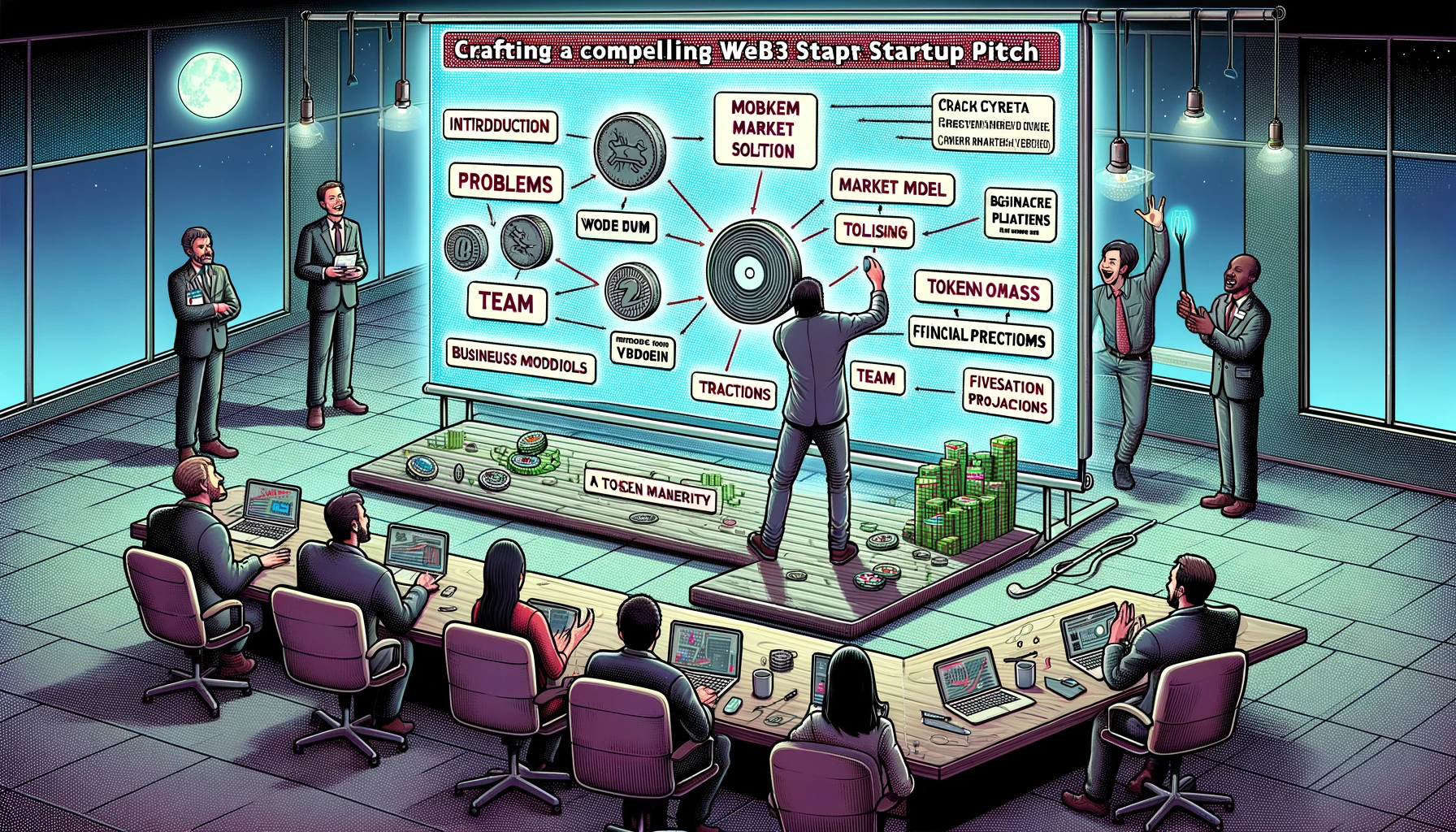
A successful Web3 startup pitch hinges on your ability to present your vision, strategy, and potential in a succinct yet compelling manner. Your pitch deck, serving as the cornerstone of this presentation, should be a visual narrative guiding investors through your startup's story.
Essential Slides in a Web3 Pitch Deck:
Introduction Slide: Clearly define what your startup does, its mission, and vision. This sets the tone for the rest of the presentation.
Problem and Solution: Articulate the problem you're addressing, followed by your unique solution, showcasing its relevance and innovation.
Market Analysis: Demonstrate an understanding of your market size, growth potential, and position within the Web3 ecosystem.
Product Demo: A visual or interactive demonstration of your product helps in illustrating its functionality and user experience.
Business Model: Explain how your startup will generate revenue and achieve sustainability.
Team: Highlight the expertise and experience of your team members, underscoring their ability to execute the vision.
Traction: Demonstrate the progress and market acceptance of your product, including user growth, partnerships, and key milestones achieved.
Token Utility and Tokenomics (if applicable): For tokenized startups, detail the utility of your token and the tokenomics model, explaining how it underpins the project's value and sustainability.
Financial Projections: Present realistic financial forecasts, including expected revenue, costs, and profitability timeline.
Roadmap: Show a clear roadmap of your product development, milestones, and future plans.
Investment Ask and Use of Funds: Be clear about how much funding you're seeking and how it will be utilized to grow the business.
Each slide should be crystal clear, concise, and visually engaging. Avoid overloading slides with text or technical jargon. Your objective is to weave a story that not only highlights your startup's potential but also resonates with the investors' expectations and interests.
And if you want to get your pitch reviewed by a professional VC analyst, with detailed feedback and recommendations for improvements, before sending it to VC investors, join our weekly "Pitch Perfect" sessions with VC analysts and get it nailed.
Tactical Advice for Web3 Startup Founders

Here is some tactical advice sourced from seasoned VC analysts and successful crypto founders:
Understand the Investor's Perspective: Know what your investors are looking for. Some might be driven by technological innovation, while others prioritize financial returns. Tailor your pitch to address these specific interests.
Highlight Scalability and Adaptability: Emphasize how your startup can scale and adapt in the ever-evolving Web3 environment. Showcase potential for growth, especially in emerging blockchain ecosystems.
Focus on Community Building: In Web3, community is key. Demonstrate your strategies for community engagement and growth, highlighting how this adds value to your project.
Be Transparent About Risks and Regulations: Acknowledge the risks and regulatory challenges in the Web3 space. Show that you have a plan to navigate these complexities.
Demonstrate Product-Market Fit: Use data and user testimonials to prove that your product meets a real need in the market. Investors need to see that you understand your users and have developed a solution that resonates with them.
🦄Web3 Startups and VCs
👆Web3 startup founder, trying to reach the Product-Market-Fit.

Quality Over Quantity in the Cap Table: Be mindful of whom you're bringing on board as investors. A well-curated cap table with reputable and supportive investors can be more appealing than one with a high quantity of miscellaneous investors.
Leverage Success Stories: Learn from successful Web3 pitches. Analyze what worked for them in terms of storytelling, data presentation, and investor engagement.
Remember, each interaction with potential investors is an opportunity to not just pitch your project but also to build lasting relationships. Authenticity, clarity, and preparedness can set you apart in the competitive Web3 fundraising landscape.

In addition to strategic considerations, practical advice from those who have successfully navigated the Web3 funding landscape can be invaluable.
Andrey Shpanchuk, the founder of Osmos and CryptoMatch Bot, emphasizes the importance of a well-prepared pitch deck and comprehensive market research. He also suggests tailoring each slide in your deck to convey a specific message and emotion, refining your presentation after each pitch.
Here’s more from his fundraising experience:
Well-Prepared Pitch Deck and Market Research: It's crucial to approach investors with a thoroughly prepared pitch deck and comprehensive market research. This preparation shows that you understand the market and your startup's place in it. A well-researched presentation demonstrates your serious and strategic approach, which can significantly influence investor perception.
Doing Your Homework: Before pitching, research your potential investors. Understand their interests, past investments, and professional background. Tailoring your pitch to resonate with each investor's preferences can make a substantial difference. After the pitch, send a summary emphasizing the aspects that the investor found most compelling. This personalized follow-up can help reinforce the strengths of your pitch.
Crafting Each Slide with Intent: Be deliberate with each slide in your deck. Plan the key message and emotion you want to leave with the investor. After each pitch, refine your presentation to ensure that your intended message and emotional impact align with the investor's response. This continuous improvement helps in perfecting your pitch over time.
Meanwhile, the founder of the NFTFI platform Eesee Vova Sadkov stresses the need for clarity in every interaction with investors:
"Clarity is king in every interaction with investors. As founders, it's essential to approach each call or meeting with a transparent and definite purpose. Whether you're seeking funding, strategic advice, feedback, or introductions to other investors, state your objectives clearly. Making your idea, ask, and goals easily understandable not only facilitates clearer communication but also increases the likelihood of getting a definitive answer. This clarity helps investors quickly grasp the essence of your proposal and how they can contribute, streamlining the decision-making process."
Abdul Rahman, VC analyst at InnMind shared his advice, based on reviewing thousands of pitches of web3 startups and closing hundreds of investment deals in web3:
“Web3 VCs are very different from Traditional VCs. They are well aware of the current web3 landscape, the latest infrastructures and tools. So during a pitch, or even in your deck. Focusing on that X factor that you are doing from everyone else, “the outlier”, that's what they are looking for.
If you cloud that x factor with a bunch of extras that you are solving, then they may not be able to see.
Be logical and sensible why there is a need and a reason for your product to exist. Do not make it sound like another crypto project trying to raise funds.
If it is a consumer-based application, better to focus on the web3 component as the backbone technology that powers your application, which is made for all users, not just the ones who are native to Web3.”
Crypto VC Investors' Advice to Founders

Gaining insights directly from those funding Web3 startups is invaluable for founders. We reached out to active crypto VC investors on InnMind for their insights, and here’s the essential advice they shared:
Joe Su, the founding partner at Stratified Capital:
"Value comes from feasible solutions to real pain points. Three things should be clearly defined: What’s the problem you found, what’s the solutions you get, and what’s you differentiation. In addition, turn these answers into simple vision/illustration as punchline.
At this market situation, having clear token/economic plan is especially important. Though the market fluctuates, team should at least have the plan ready to be agile to capture the market momentum”
Elaine Yang, Investment Director at Waterdrip Capital:
"As a Web3 investor, I've found that beyond the technology itself, what truly impresses us in a pitch is a clear demonstration of real-world applicability. show us your demo solution compared with other competitors and how much deep research you have done, you have to understand the market better than anyone even the investors, and how you achieve product-market fit, and user adoption strategies alongside the technology. Ultimately, a compelling pitch not only showcases innovation but also aligns it with market demands and user needs."
Dima Foremnyi, General Partner at 3x Capital
"My best advice is to create separate decks for pitching and sending over emails.
The first one should have no more than 20 words per slide, be more visual to support your oral pitch and serve as a teaser for getting in touch with the founder.
The second one will be more comprehensive. You can send it over email, allowing the reader to dive deep while reading.
Don’t mix the two for the best experience. The reason for this is the human physiology. One can't comprehend the information both with eyes and ears at the same time. Make it easier for the investor to read or listen to you efficiently".
Riccardo Pagano, from Outlier Ventures:
"Showing is better than telling. I am a very visual learner. While a full product demo might not be feasible in a first pitch, using product snapshots to illustrate how you solve the problem for your target user can be highly effective. It helps me visualize the user experience more clearly in my mind."
Don’t underestimate the importance of visually engaging elements in a pitch. Founders should consider incorporating visual aids that succinctly convey their solution's impact, making it easier for investors to understand and remember the key aspects of their product.
Mark Leontev, from DeepWaters Capital:
“Beware of what we call 'marketing-speak'. Terms like 'groundbreaking' or 'revolutionizing' are less effective because they don't specify what you actually do, which is crucial for us to know. Don’t try too hard to convince us; simply prove it with objective data and straightforward language. For instance, instead of saying 'revolutionary product', specify 'a product that reduces processing time by 30%'. Show your company's value clearly and concisely and stick to the best practices”
Senior Venture Analyst at Insolvent Capital, Alina C:
"The average attention span of a VC is lower than that of the average person. Go straight to the point: problem, solution, your edge from competitors. You got cool traction - wrap me up with it! Save yourself and VCs time and they will love you for it."
Success Stories: Analyzing Winning Web3 Pitches
The Web3 industry is rich with stories of crypto and blockchain startups that have successfully captivated investors and secured millions of funding in their early stages. Their success is attributed not only to favorable market conditions but also to their compelling narratives and ambitious ideas. Analyzing these success stories provides valuable lessons for founders on what makes a pitch stand out.
On the InnMind knowledge base, you can find plenty of such examples, including pitch decks of CoinList, FTX, Coinbase, Revolut, and other well-known names from the times when they were raising their early funding.
CoinList Pitch Deck Example - InnMind KB
This CoinList pitch deck helped to raise $100 million in series A funding and achieve unicorn status with a billion-dollar valuation in 2021.

Analyzing successful Web3 pitches reveals common threads that led to their triumph, so we highly recommend you to download and study these decks. By dissecting these success stories, you can gain insights into the strategies that resonate with investors and learn how to replicate this success in your pitch.
Our analysis of these success stories reveals several common factors contributing to their triumph:
- Understanding the Market and Audience:
Successful pitches often stem from a deep understanding of the market and the target audience. Startups that clearly articulate how they address specific needs or gaps in the Web3 space stand a better chance of resonating with investors.
- Innovative Solutions with Practical Applications:
Pitches that showcase innovative solutions, especially those with practical, real-world applications, tend to attract more interest. Demonstrating how your solution can be implemented effectively in the current market can significantly boost its appeal.
- Clear and Concise Pitch Decks:
A well-structured, clear, and concise pitch deck is a common feature of successful pitches. These decks effectively communicate the startup's value proposition, market potential, and unique selling points without overwhelming the audience with information.
- Strong Team Presentation:
Investors often invest in people as much as they invest in ideas. Successful pitches usually include a compelling presentation of the team, highlighting their expertise, experience, and passion for the project.
- Evidence of Traction and Growth Potential:
Startups that provide evidence of traction, such as user growth, partnerships, or early adopter feedback, offer tangible proof of their potential. This evidence helps build investor confidence in the startup's future growth.
By incorporating these elements, Web3 founders can craft pitches that not only showcase their startup’s potential but also align with what investors are looking for in a successful venture.
Engaging and Persuading Investors with Your Pitch
Engaging and persuading investors require more than just presenting facts; it involves connecting with them on a deeper level and requires a blend of storytelling, clarity, and strategic presentation.
Here are some key techniques to make your pitch stand out:
Storytelling: Start by telling the story of your startup. Explain why it exists, the challenges it aims to solve, and the journey so far. A compelling narrative that connects emotionally with investors can be very persuasive.
Visual Aids: Utilize visual elements effectively. Infographics, charts, and product snapshots can help investors visualize the problem, solution, and impact of your product. Echoing Riccardo Pagano from Outlier Ventures, "Showing is better than telling." Use visual aids to make complex ideas easily understandable.
Clear Value Proposition: Articulate a clear value proposition. Explain what sets your startup apart and why it’s a worthy investment. Be specific about how your solution addresses a gap in the market.
Data and Evidence: Support your claims with data. Market research, user statistics, and growth metrics can validate your business model and market potential. Tangible evidence strengthens your case and builds credibility.
Engage with Q&A: Be prepared for a thorough Q&A session. Engaging with investors’ questions thoughtfully and thoroughly can demonstrate your expertise and commitment to the project.
Passion and Enthusiasm: Your enthusiasm for your project can be infectious. Show your passion and belief in your startup’s potential. Investors are not just investing in an idea; they’re investing in the team behind it.
Practice and Refine: Practice your pitch multiple times. Refine it based on feedback and your own observations. Each pitch is an opportunity to improve and adapt.
In essence, remember that investors are not just investing in an idea; they are investing in people. Show passion, conviction, and a clear vision for the future. Your enthusiasm can be infectious, making investors more inclined to join you on your journey.
Conclusion: Summarizing Key Takeaways for Web3 Fundraising
Approaching Web3 investors successfully requires a blend of clarity, innovation, and strategic thinking. Founders must:
- Understand Investor Psychology: Recognize the unique perspectives and expectations of Web3 investors, tailoring your pitch to meet their specific interests.
- Articulate Your Value Proposition: Clearly and compellingly present your startup's purpose, market potential, and what sets it apart.
- Leverage Success Stories: Draw insights from successful Web3 pitches, learning how to effectively communicate your startup's potential.
- Engage Investors with a Compelling Narrative: Use storytelling, data, and visual aids to make your pitch engaging and persuasive, and prepare for interactive Q&A sessions to showcase your expertise.
Remember, at its core, a successful pitch is a story well told – one that resonates with the aspirations and convictions of its audience.
For startup founders ready to embark on this journey, InnMind presents a valuable platform. As a leading hub for Web3 startups and VCs, InnMind enables founders to connect directly with investors, pitch innovative ideas, and access essential resources. Register on InnMind, start reaching out to active crypto VCs, and open the doors to potential investors and fundraising opportunities in the Web3 world.
Embrace these strategies, connect with the right people, and pave your way to a successful Web3 venture.
Read also:
The Top 10 Grant Providers for Blockchain & Web3 Startups in 2023 | Part 2
We continue sharing the best grant options for Crypto and Web3 startups in 2023. The first part of the compilation is here, and for those ready for their first pitching, InnMind conducts regular Pitching Sessions with investors. 1. Stellar Community Fund Stellar, an open-source network designed…

Your Guide to Decoding VC Investor Signals in Web3
Discover the signs that investors may not be as interested as they seem in your web3 startup. Decode the VC language for efficient fundraising.
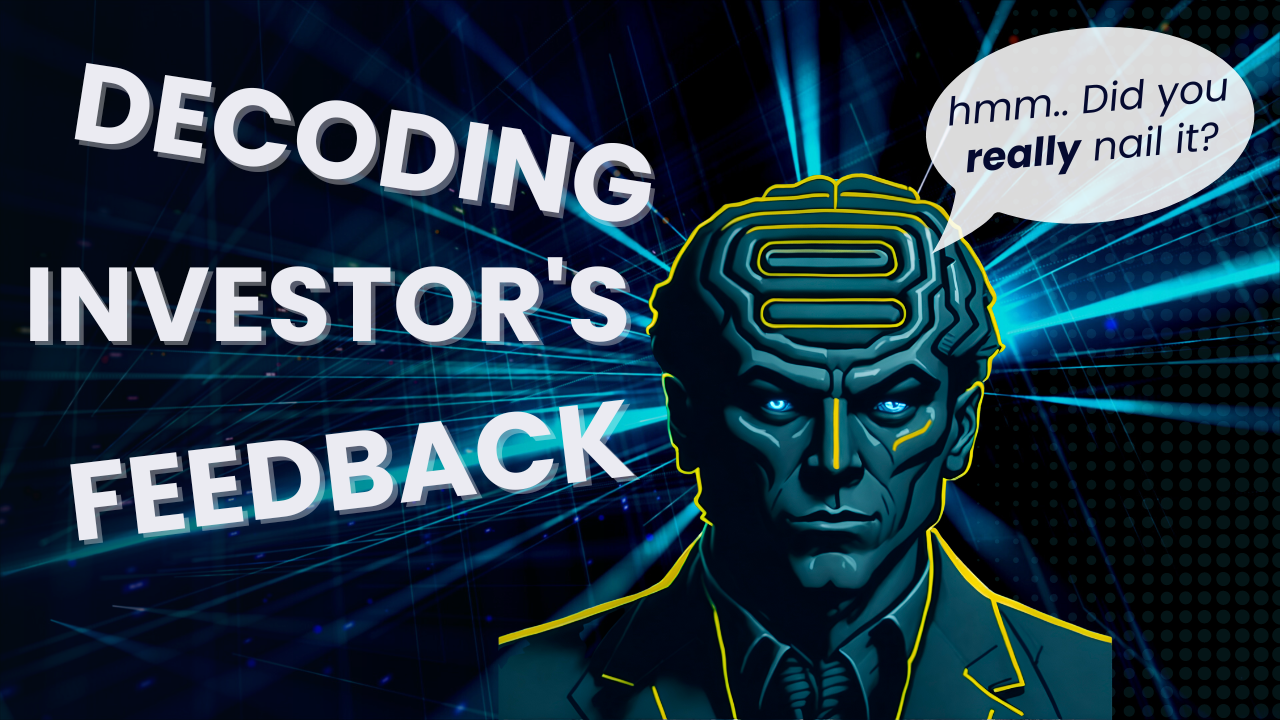
Top 20 Active Web3 VCs, Investing in 2023 Bear Market
The crypto winter is still there, but there are active venture capital firms that invest in early-stage crypto and web3 startups and deploy capital

- SEO Powered Content & PR Distribution. Get Amplified Today.
- PlatoData.Network Vertical Generative Ai. Empower Yourself. Access Here.
- PlatoAiStream. Web3 Intelligence. Knowledge Amplified. Access Here.
- PlatoESG. Carbon, CleanTech, Energy, Environment, Solar, Waste Management. Access Here.
- PlatoHealth. Biotech and Clinical Trials Intelligence. Access Here.
- Source: https://blog.innmind.com/pitching-to-web3-investors-best-practices/
- :has
- :is
- :not
- $100 million
- $UP
- 1
- 10
- 20
- 2021
- 2023
- 28
- 35%
- 39
- a
- ability
- Able
- About
- acceptance
- access
- accessing
- Achieve
- achieved
- achievements
- active
- active crypto
- actually
- adapt
- addition
- address
- addresses
- addressing
- Adds
- Adoption
- advice
- After
- agile
- aids
- aims
- align
- aligning
- Aligns
- All
- Allowing
- along
- alongside
- already
- also
- am
- ambitious
- an
- analysis
- analyst
- Analysts
- analyze
- analyzing
- and
- Another
- answer
- answers
- anyone
- apart
- appeal
- appealing
- applicable
- Application
- applications
- applies
- approach
- arbitrum
- ARE
- article
- AS
- ask
- aspects
- assess
- Assets
- At
- attention
- attract
- audience
- authenticity
- average
- avoid
- aware
- Backbone
- backed
- background
- based
- BE
- Bear
- Bear Market
- because
- before
- behind
- belief
- BEST
- best practices
- Better
- between
- Beware
- Beyond
- Blend
- blockchain
- blockchain & web3
- blockchain ecosystem
- blockchain platform
- Blockchain Startups
- blockchain technology
- board
- boost
- both
- Bringing
- build
- Building
- builds
- built
- bull
- Bull Run
- Bunch
- business
- business model
- but
- by
- call
- CAN
- cap
- capabilities
- capital
- capture
- case
- chains
- challenges
- Chance
- chances
- Charts
- chosen
- claims
- clarity
- clear
- clearer
- clearly
- closing
- Cloud
- coinbase
- COINLIST
- combine
- comes
- commitment
- Common
- communicate
- communicating
- Communication
- community
- community building
- company
- compared
- compelling
- competitive
- competitors
- complex
- complexities
- component
- comprehend
- comprehensive
- concise
- conditions
- conducts
- confidence
- Connect
- Connecting
- connects
- Consider
- considerations
- continue
- continuous
- contribute
- contributing
- conviction
- convince
- Cool
- Core
- cornerstone
- Costs
- craft
- create
- Credibility
- criteria
- critical
- crucial
- crypto
- Crypto investors
- Crypto Winter
- Crystal
- Current
- data
- Deals
- decentralized
- Deciding
- Decision Making
- deck
- Decoding
- deep
- deeper
- DeFi
- define
- defined
- definitive
- demands
- Demo
- demonstrate
- demonstrates
- demonstrating
- deploy
- detail
- detailed
- developed
- Development
- difference
- differences
- different
- difficult
- directly
- Director
- dive
- do
- does
- doing
- don
- done
- Dont
- doors
- down
- download
- driven
- during
- dynamic
- each
- Early
- early stage
- earn
- easier
- easily
- ecosystem
- Ecosystems
- Edge
- Effective
- effectively
- efficient
- efficiently
- elements
- else
- emails
- embark
- embrace
- emerging
- emotion
- emphasizes
- emphasizing
- enables
- engagement
- engaging
- ensure
- enthusiasm
- Environment
- especially
- essence
- essential
- Ether (ETH)
- evaluate
- evaluated
- Even
- Every
- everyone
- evidence
- evident
- example
- examples
- execute
- exist
- exists
- Exit
- expectations
- expected
- experience
- expertise
- Explain
- explaining
- Eyes
- facilitates
- factor
- factors
- facts
- far
- favorable
- feasible
- Feature
- feedback
- financial
- financial health
- Find
- firms
- First
- fit
- fixed
- fluctuates
- Focus
- focusing
- followed
- For
- For Investors
- For Startups
- forecasts
- found
- founder
- founders
- founding
- from
- FTX
- full
- functionality
- fund
- funded
- funding
- funding rounds
- Fundraising
- funds
- future
- future growth
- Gain
- gained
- Gamefi
- gap
- gaps
- General
- General Partner
- generate
- get
- getting
- Go
- Goals
- got
- grant
- grasp
- groundbreaking
- Grow
- Growing
- growing interest
- Growth
- growth potential
- guide
- Hard
- Have
- having
- he
- Health
- help
- helped
- helps
- here
- High
- highlighting
- highlights
- highly
- hinder
- hinges
- his
- homework
- How
- How To
- HTTPS
- Hub
- huge
- human
- Hundreds
- i
- idea
- ideas
- if
- illustrate
- illustrating
- Impact
- implemented
- importance
- important
- improve
- improvement
- improvements
- in
- Inclined
- include
- Including
- incorporating
- Increase
- Increases
- incredibly
- industry
- influence
- information
- Infrastructure
- infrastructures
- initial
- Innovation
- innovative
- insights
- instance
- instead
- Integrates
- intended
- intent
- interaction
- interactive
- interest
- interested
- interests
- into
- introductions
- invaluable
- Invest
- investing
- investment
- Investments
- investor
- Investors
- involves
- IT
- ITS
- itself
- jargon
- join
- journey
- jpg
- just
- Key
- King
- Know
- knowledge
- landscape
- language
- lasting
- latest
- LAYERZERO
- leading
- LEARN
- learner
- learning
- least
- Leave
- Led
- less
- Lessons
- Level
- leverages
- like
- likelihood
- Liquid
- logical
- Look
- looking
- losses
- love
- lower
- made
- Majority
- make
- MAKES
- Making
- manner
- many
- Market
- market conditions
- market research
- Markets
- Matters
- May..
- me
- Meet
- meeting
- Meets
- Members
- message
- Metaverse
- Metrics
- might
- Milestones
- million
- millions
- mind
- Mission
- mix
- model
- more
- most
- much
- multiple
- must
- my
- names
- NARRATIVE
- narratives
- native
- Nature
- Navigate
- Need
- needs
- network
- New
- NFT
- nft market
- NFT portfolio
- NFTfi
- niche
- no
- notable
- objective
- objectives
- observations
- of
- offer
- often
- on
- ONE
- ones
- only
- open
- open source
- opening
- opportunities
- Opportunity
- opposite
- Options
- or
- oral
- Other
- Others
- our
- out
- outlier
- over
- overwhelming
- own
- Pain
- Pain points
- part
- particularly
- partner
- partnerships
- passion
- past
- pave
- People
- per
- perception
- perfect
- perfecting
- person
- Personalized
- perspective
- perspectives
- picture
- Pitch
- pitch deck
- pitches
- pitching
- Place
- plan
- plans
- platform
- plato
- Plato Data Intelligence
- PlatoData
- Plenty
- Point
- points
- Polygon
- portfolio
- portfolios
- position
- potential
- powers
- Practical
- Practical Applications
- practices
- preferences
- preparation
- Prepare
- prepared
- present
- presentation
- presents
- principle
- principles
- Prioritize
- Problem
- process
- processing
- Product
- product development
- product-market-fit
- professional
- profitability
- Progress
- project
- projections
- projects
- proof
- proposal
- proposition
- Prove
- provide
- providers
- provides
- Psychology
- purpose
- Q&A
- quality
- quantity
- Questions
- quickly
- raise
- raising
- RE
- reach
- reached
- reaching
- Read
- Reader
- Reading
- ready
- real
- real world
- realistic
- realize
- reason
- recognize
- recommend
- recommendations
- reduces
- refine
- refining
- reflects
- register
- regular
- regulations
- regulatory
- reinforce
- Relationships
- relevance
- remember
- reputable
- require
- requires
- research
- Resonate
- resonates
- resonating
- Resources
- response
- REST
- returns
- Reveals
- revenue
- reviewed
- reviewing
- Revolut
- revolutionary
- Revolutionizing
- Rich
- right
- Risk
- risks
- roadmap
- ROI
- rounds
- Run
- s
- same
- Save
- savvy
- saying
- Scalability
- scalable
- Scale
- seasoned
- Second
- sector
- Sectors
- secure
- Secured
- securing
- see
- Seek
- seeking
- seem
- Selling
- send
- sending
- separate
- Series
- Series A
- Series A funding
- serious
- serve
- serving
- session
- sessions
- set
- Sets
- several
- severely
- shaped
- shared
- sharing
- shift
- should
- show
- showcase
- showcasing
- showing
- Shows
- signals
- significant
- significantly
- Signs
- Simple
- simply
- simultaneously
- situation
- Size
- Slide
- Slides
- So
- so Far
- socialfi
- Solana
- solution
- Solutions
- SOLVE
- Solving
- some
- Sound
- sourced
- Space
- spam
- span
- specific
- Stage
- stages
- stand
- start
- startup
- Startups
- State
- statistics
- Status
- Stellar
- Stem
- Stick
- Still
- Stories
- Story
- storytelling
- straight
- straightforward
- Strategic
- strategic approach
- strategies
- Strategy
- streamlining
- strength
- Strengthens
- strengths
- Study
- substantial
- success
- Success Stories
- successful
- Successfully
- such
- Suggests
- SUMMARY
- support
- supportive
- Sustainability
- T
- table
- tactical
- tailoring
- Takeaways
- tangible
- Target
- team
- Team members
- teaser
- Technical
- techniques
- technological
- Technology
- telling
- terms
- text
- than
- that
- The
- The Future
- the information
- their
- Them
- then
- There.
- These
- they
- things
- Thinking
- this
- thoroughly
- those
- though?
- thousands
- three
- Through
- Thus
- time
- Timed
- timeline
- timelines
- times
- tips
- to
- token
- tokenized
- tokenomics
- told
- Ton
- TONE
- too
- tools
- top
- Top 10
- touch
- traction
- traditional
- traditional markets
- transparent
- triumph
- truly
- try
- trying
- TURN
- two
- typically
- Ultimately
- understand
- understandable
- understanding
- unicorn
- unicorn status
- unique
- us
- use
- User
- User Adoption
- User Experience
- users
- using
- usually
- utility
- utilized
- VALIDATE
- Valuable
- Valuation
- value
- value proposition
- various
- VC
- VC funding
- VCs
- Ve
- venture
- venture capital
- venture capital Firms
- Ventures
- vertical
- verticals
- very
- vision
- visionary
- visions
- visual
- visualize
- visually
- want
- was
- Way..
- we
- Weave
- Web2
- Web3
- Web3 Ecosystem
- web3 funding
- Web3 industry
- Web3 space
- Web3 world
- weekly
- WELL
- well-known
- were
- What
- when
- whether
- which
- while
- WHO
- whom
- why
- will
- Willingness
- winning
- Winter
- with
- within
- without
- words
- worked
- world
- worthy
- wrap
- X
- yet
- you
- Your
- yourself
- zephyrnet

